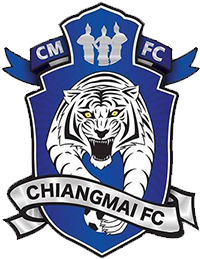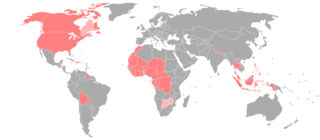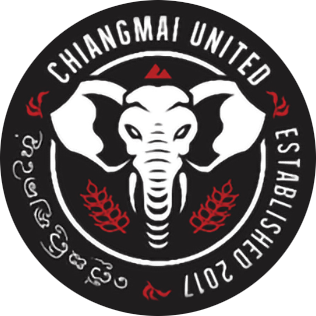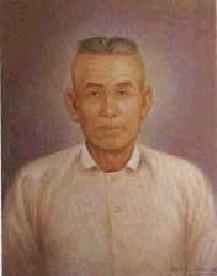Related Research Articles

The Lan Na Kingdom, also known as Lannathai, and most commonly called Lanna or Lanna Kingdom, was an Indianized state centered in present-day Northern Thailand from the 13th to 18th centuries.

Chiang Mai, sometimes written as Chiengmai or Chiangmai, is the largest city in northern Thailand, the capital of Chiang Mai province and the second largest city in Thailand. It is 700 km (435 mi) north of Bangkok in a mountainous region called the Thai highlands and has a population of 1.19 million people as of 2022, which is more than 66 percent of the total population of Chiang Mai province.

Chiang Mai International Airport is an international airport serving Chiang Mai, the capital city of Chiang Mai Province in Thailand. It is a major gateway to Northern Thailand, and currently the fourth-busiest airport in the country.
Providence Island Sign Language is a village sign language of the small island community of Providence Island in the Western Caribbean, off the coast of Nicaragua but belonging to Colombia. The island is about 15 square miles (39 km2) and the total population is about 5000, of which an unusual proportion are deaf.

Thai Sign Language (TSL), or Modern Standard Thai Sign Language (MSTSL), is the national sign language of Thailand's deaf community and is used in most parts of the country by the 20 percent of the estimated 56,000 pre-linguistically deaf people who go to school.
The three deaf-community sign languages indigenous to Vietnam are found in Ho Chi Minh City, Hanoi, and Haiphong. The HCMC and Hanoi languages especially have been influenced by the French Sign Language (LSQ) once taught in schools, and have absorbed a large amount of FSL vocabulary.
Chiang Mai is a major city in northern Thailand.
The Chet Ton Dynasty, also spelled Jedton, or officially Thipphachakkrathiwong Dynasty or Thipphachak Dynasty in The Royal Society of Thailand's spelling style or Dibayachakkradhiwongse Dynasty in Prajadhipok's spelling style is a dynasty that ruled 3 northern states of Siam, which consisted of Chiang Mai, the largest, Lampang and Lamphun.

Chiangmai Football Club, formerly known as Chiangmai F.C., is a Thai professional football club based in Chiang Mai province, a province located in the northern part of Thailand. The club plays in Thai League 2. Their main home ground at Chiang Mai Municipality Stadium.
Haiphong Sign Language is the deaf-community sign language of the city of Haiphong in Vietnam. It is about 50% cognate with the other sign languages of Vietnam, and has been less influenced than them by the French Sign Language once taught in Vietnamese schools for the deaf. It shares cognates with the languages of the Old Chiangmai–Bangkok Sign Language family of Thailand; the deaf-community sign langes of Vietnam, Thailand and Laos may be genealogically related, or there may be a history of population movement that has cause them to have words in common.
A village sign language, or village sign, also known as a shared sign language, is a local indigenous sign language used by both deaf and hearing in an area with a high incidence of congenital deafness. Meir et al. define a village sign language as one which "arise[s] in an existing, relatively insular community into which a number of deaf children are born." The term "rural sign language" refers to almost the same concept. In many cases, the sign language is known throughout the community by a large portion of the hearing population. These languages generally include signs derived from gestures used by the hearing population, so that neighboring village sign languages may be lexically similar without being actually related, due to local similarities in cultural gestures which preceded the sign languages. Most village sign languages are endangered due to the spread of formal education for the deaf, which use or generate deaf-community sign languages, such as a national or foreign sign language.

Central Chiangmai Airport, previously known as CentralPlaza Chiang Mai Airport and Central Airport Plaza, is a shopping mall in Mueang District, Chiang Mai. The shopping malls was established as Tantraphan Airport Plaza in 1987. Central Pattana took over and re-branded the shopping mall to Central Airport Plaza in March 1996. In early 2022, CentralPlaza Chiang Mai Airport underwent a minor name change and is now known as Central Chiang Mai Airport, which is part of Central Pattana's efforts to simplify the Central brand across Thailand.
Bangkok Sign Language is a deaf-community sign language of Thailand that arose among deaf people who migrated to Bangkok for work or family. The language is moribund, with all speakers born before 1960. Younger generations have switched to Thai Sign Language, which seems to have arisen as a mixture of Old Bangkok SL and American Sign Language.
There are an unknown number of indigenous deaf sign languages in Laos, which may have historical connections with the languages indigenous to Vietnam and Thailand, though it is not known if they are related to each other. There is no single "Laotian Sign Language". Sign languages in use in Laos include French Sign Language, American Sign Language, Thai Sign Language, Lao Sign Language, and Home sign.
Cambodian Sign Language (CBDSL) is an indigenous deaf sign language of Cambodia.
The Old Chiangmai–Bangkok Sign Language family is a language family of two related sign languages: Old Chiangmai Sign Language and Old Bangkok Sign Language. Woodward (2003) found that they were 65% cognate, indicating that the two languages are related, possibly due to migration between Chiangmai and Bangkok. There appear to be connections to sign languages of Vietnam, and possibly Laotian sign languages, but the nature of these connections has not been determined. Village sign languages of Thailand, such as Ban Khor Sign Language, are unrelated.

American Sign Language (ASL) developed in the United States and Canada, but has spread around the world. Local varieties have developed in many countries, but there is little research on which should be considered dialects of ASL and which have diverged to the point of being distinct languages.

Chiangmai United Football Club is a Thai professional football club based in Chiang Mai province, Thailand.

Khamfan was the eighth son of Chao Pha Chai Keaw and Phra Mae Chao Chantadevi.
Deafness in Thailand refers to the population and culture of Deaf Hard of Hearing people in Thailand. Deafness in Thailand includes language emergence, organizations, healthcare, employment, schooling, and civil rights.
References
- ↑ James Woodward and Thanu Wongchai. Forthcoming 2015. Original Chiang Mai Sign Language. In J. Hansen, W. McGregor, G. De Clerck and S. LutaloKlingi (eds.) The World's Sign Languages. Berlin: De Gruyter Mouton.